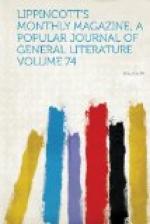If it were possible, of course the best treatment for fever would be that which lessened the production of heat. Fortunately, we have some drugs—notably, quinine and alcohol—which do exert a decided influence upon the vital chemical movements, but, unfortunately, their power is limited. As we are therefore often unable to control heat-production, the best we can do is to abstract the caloric from the body whenever it becomes so excessive as to threaten serious results. To do this, all that is necessary is to put the patient in a cold bath, or wrap him in a sheet wet with ice-cold water, or lay him upon an ice-mattress, or surround him with coils of tubing through which cold water runs, or use some similar efficacious device. I do not wish to be misunderstood. External cold is not to be lightly employed: it is a powerful two-edged weapon, capable of cutting both ways—a weapon as injurious and destructive in the hands of the ignorant and inexperienced as it is efficient in the hands of those to whom study and experience have taught its skillful use.
To illustrate what cold water may effect when employed by intelligent and skillful physicians, I may be permitted to cite a few hospital statistics from Germany and Switzerland, the only countries where the so-called antipyretic treatment of continued fever has been efficiently carried out on a large scale. From 1850 to 1861 there were treated without cold water, at the hospital at Kiel, 330 cases of typhoid fever, with 51 deaths—a mortality of about 15-1/2 per cent.; from 1863 to 1866, 160 cases were treated with cold baths, with 5 deaths—a mortality of only 3-1/10 per cent. In the hospital of Bale, from 1843 to 1864, there were 1718 cases without antipyretic treatment, with 469 deaths—a mortality of about 27-1/2 per cent; from September, 1866, to 1873, 1121 cases were treated antipyretically, with 92 deaths—a mortality of a little over 8 per cent. Assuredly, we may claim that this water-treatment in typhoid fever is one of the greatest gains of modern medicine since the discovery of anaesthesia.
Some of my readers may here say to themselves, “Why, this is hydropathy!” Not so. It is the legitimate, not the illegitimate, use of cold water. It is the use of it as a single weapon, not as the only weapon of the armory. It is the employment of it in a single affection, not as a cure for all diseases.
Perhaps, in concluding this essay, I may be pardoned one word of counsel to my lay audience. Any physician who proclaims himself a follower of any special doctrine, be he a hydropath, an electropath, an allopath, a homoeopath, or any other path, should be viewed with suspicion. Water, cold, heat, electricity, drugs, are all agents capable of being used advantageously in the treatment of disease. Above all men, the physician ought to have that teachable spirit which is the offspring of true humility. Knowing the grave responsibilities which he assumes, living almost beneath the shadow of that past whose life-imperiling mistakes are so plainly visible in the light of the present, he, of all men, should be ever seeking for new knowledge, gathering with equal zest the seeds of healing in the waste as well as in the cultivated places, amongst the lowest and most ignorant of the populace, as well as in far-famed schools of medicine.




